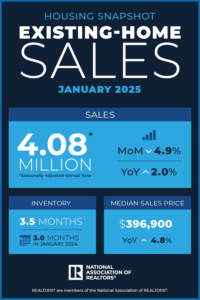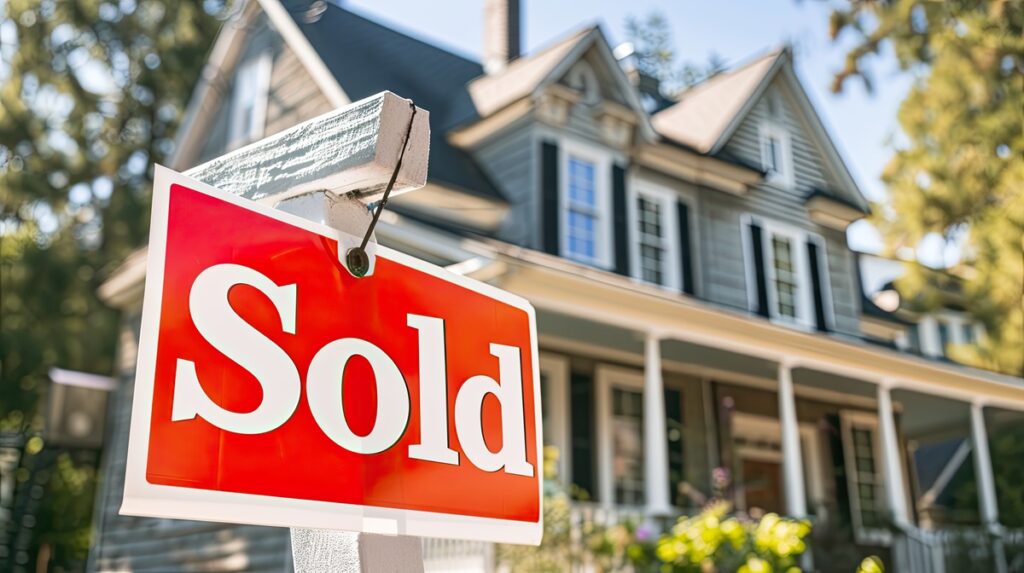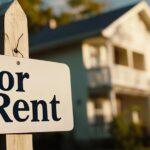 According to the National Association of Realtors (NAR), existing-home sales retreated in January 2025, slipping in three major U.S. regions, while holding steady in the Midwest. Year-over-year, sales rose in three regions and were unchanged in the South.
According to the National Association of Realtors (NAR), existing-home sales retreated in January 2025, slipping in three major U.S. regions, while holding steady in the Midwest. Year-over-year, sales rose in three regions and were unchanged in the South.
Total existing-home sales–defined as completed transactions that include single-family homes, townhomes, condominiums, and co-ops–descended 4.9% from December to a seasonally adjusted annual rate of 4.08 million in January. Year-over-year, sales improved 2.0% (up from four million in January 2024).
“Mortgage rates have refused to budge for several months despite multiple rounds of short-term interest rate cuts by the Federal Reserve,” said NAR Chief Economist Lawrence Yun. “When combined with elevated home prices, housing affordability remains a major challenge.”
Inventory Up
Total housing inventory registered at the end of January was 1.18 million units, up 3.5% from December and 16.8% from one year ago (1.01 million). Unsold inventory sits at a 3.5-month supply at the current sales pace, up from 3.2 months in December and three total months in January 2024.
“More housing supply allows strongly qualified buyers to enter the market,” Yun said. “But for many consumers, both increased inventory and lower mortgage rates are necessary for them to purchase a different home or become first-time homeowners.”
The median existing-home price for all housing types in January was $396,900, up 4.8% from one year ago ($378,600). All four U.S. regions registered price increases.
While housing inventory may be up, recent concerns over tariffs, elevated mortgage rates, and high housing costs have forced builder confidence downward, according to the National Association of Home Builders (NAHB). Builder confidence in the market for newly built single-family homes was 42 in February, down five points from January and the lowest level in five months, according to the most recent NAHB/Wells Fargo Housing Market Index (HMI).
“While builders hold out hope for pro-development policies, particularly for regulatory reform, policy uncertainty and cost factors created a reset for 2025 expectations in the most recent HMI,” said NAHB Chairman Carl Harris, a custom home builder from Wichita, Kansas. “Uncertainty on the tariff front helped push builders’ expectations for future sales volume down to the lowest level since December 2023. Incentive use may also be weakening as a sales strategy as elevated interest rates reduce the pool of eligible home buyers.”
The latest HMI survey also revealed that 26% of builders cut home prices in February, down from 30% in January and the lowest share since May 2024. Meanwhile, the average price reduction was 5% in February, the same rate as the previous month. The use of sales incentives was 59% in February, down from 61% in January.
The monthly REALTORS Confidence Index found that properties typically remained on the market for 41 days in January, up from 35 days in December, and 36 days in January 2024.
First-time buyers were responsible for 28% of sales in January, down from 31% in December 2024 and identical to January 2024. NAR’s 2024 Profile of Home Buyers and Sellers, released in November 2024, found that the annual share of first-time buyers was 24%, the lowest ever recorded. Cash sales accounted for 29% of transactions in January, up from 28% in December, but down from 32% in January 2024.
Individual investors or second-home buyers, who make up many cash sales, purchased 17% of homes in January, up from 16% in December and unchanged from January 2024.
Distressed sales–foreclosures and short sales–represented 3% of sales in January, virtually unchanged from December and the previous year.
Rates Still Impact Affordability
According to Freddie Mac, the 30-year fixed-rate mortgage averaged 6.85% as of February 20. That’s down from 6.87% one week ago and 6.90% one year ago. The 30-year fixed-rate mortgage has stayed just under 7% for five consecutive weeks, and in that time, has fluctuated less than 20 basis points. This stability continues to bode well for potential buyers and sellers as peak homebuying season approaches.
Regional Breakdown
In January, existing-home sales in the Northeast waned 5.7% from December to an annual rate of 500,000, up 4.2% from January 2024. The median price in the Northeast was $475,400, up 9.5% from one year earlier. In the Midwest, existing-home sales were unchanged in January at an annual rate of 1 million, up 5.3% from the previous year. The median price in the Midwest was $290,400, up 7.2% from January 2024. Existing-home sales in the South fell 6.2% from December to an annual rate of 1.83 million in January, identical to one year before. The median price in the South was $356,300, up 3.5% from last year.
In the West, existing-home sales slumped 7.4% in January to an annual rate of 750,000, up 1.4% from a year ago. The median price in the West was $614,200, up 7.4% from January 2024.
Click here for more on NAR’s latest existing-home sales report.





